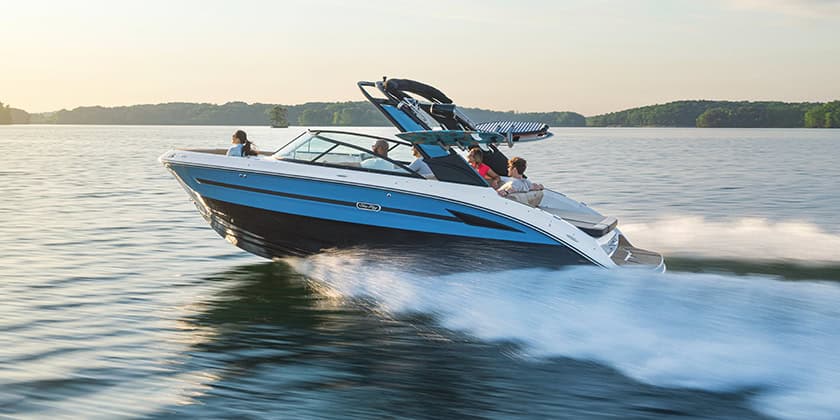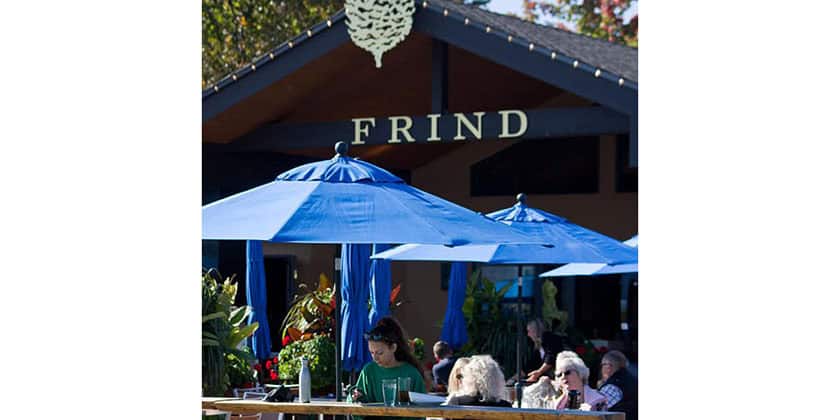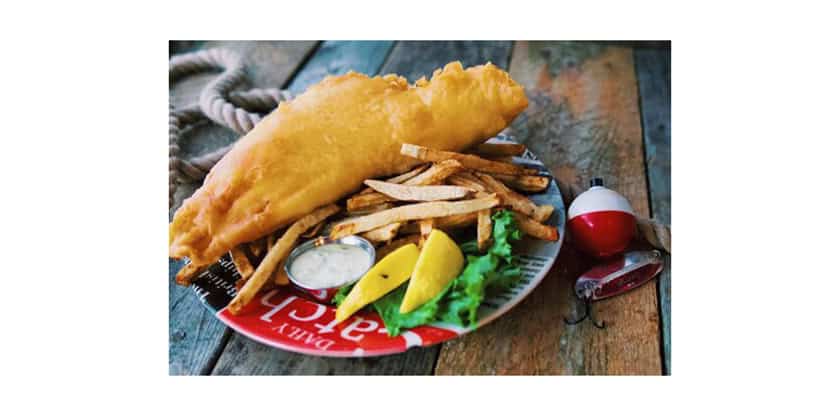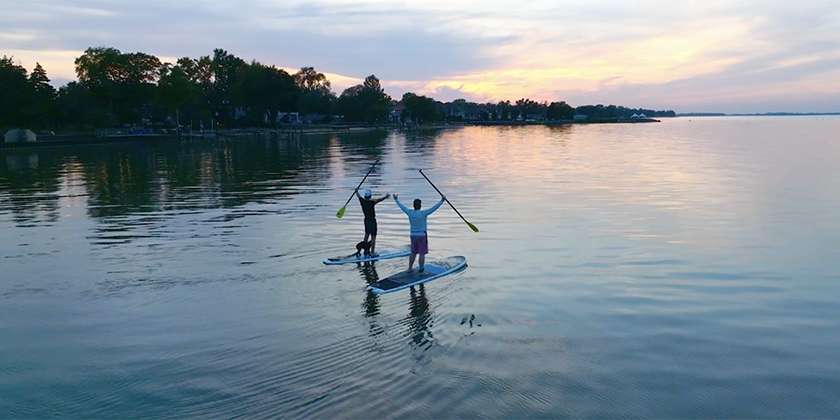Alberg 37
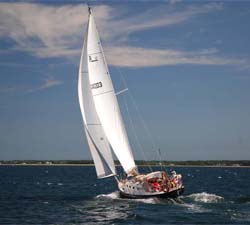 By Paul Howard
By Paul Howard
June 8…”A nice morning, but a brassy glare gets us worried. By 1130 we have rain and the wind picks up. With a third reef in the main and the genoa rolled back to a number three, we are making seven to eight knots. The boat is awash with breaking seas and spray keeps flying over the boat. My gourmet meal suffers as cutting and cooking have become a lethal exercise.”
June 23…”The wind is still very strong and veering to the north. We are unable to maintain course and are 15 miles off the rhumb line. At 0930 the wind has picked up to more than 40 knots and the seas are 25 to 30 feet high. We decide to pack it in and take all sails down. With the wheel locked, the boat drifts at about two knots but the motion is very smooth. For the first time we have no waves breaking over our bow. We overhear two freighters on the VHF and find out that we are in the centre of a storm in [with a pressure of] 1,000 millibars. Still, after six hours of well-deserved sleep, the next morning looks better.”
These are two log entries from the Alberg 37, Rabaska (an aboriginal name meaning war canoe), from Hank Borsboom’s passage to Bermuda in June 1993. In his seventh season with Rabaska, Borsboom chose the Alberg for its reputation as an ocean passage-maker. “Every year I add some more equipment,” said Borsboom in his thick Dutch accent. “To date I have added mast steps, furling gear, a windlass with three anchors and lots of rode, plus a new GPS, life raft and EPIRB for our Bermuda trip. Other upgrades include a high-output alternator, 500 amp hours of domestic battery capacity, improved wiring, and new panels, circuit breakers and battery-monitoring equipment. My next project is a new refrigeration unit in an upgraded icebox.”
The Alberg 37 was designed by Swedish-born Carl Alberg (1900-1986) for Kurt Hansen’s Whitby Boat Works. In total, 248 of these boats were built between 1967 and 1988 – the MKI model from 1967 to 1971 and the MKII until the late-’80s.
With long overhangs and a pleasing sheer, the 37 is an unmistakably classic design. Although first built as a racer/cruiser, the Alberg is now known as a traditional cruiser with medium-heavy displacement performance. During the early ’70s the AL37 was actively raced in SORC and other offshore events, but today is only occasionally seen out PHRF club racing.
Below the waterline the forefoot is cut away at the forward end of a relatively short keel. The large, raked rudder is attached directly to the keel. Low topsides, a long and narrow cockpit and a well-proportioned coach-house are other distinct features of the Alberg.
I recently spoke to Doug Stephenson, a former sales agent for Whitby Boat Works from 1981 until the factory closed in 1988. Now a broker at Bay Harbour Yachts in Midland, Ontario, Stephenson described the differences between the MKI and MKII.
“On the Mark II the toe rail was changed from wood to fibreglass. Hansen also incorporated a dodger splashguard into the deck mould. The port lights were also elongated and fewer opened. But the largest change, from a construction point of view, was the addition of a moulded floor support and liner to replace the wood that was there in the MKI. This made the boat more durable and also decreased production time.” Other modifications to the MKII included a more efficient use of interior space, allowing for a larger head and galley, as well as longer berths.
During the ’70s the Alberg was considered a boat-show “dream-boat” by Canadian sailors in the boat market. At the time, the yawl rig (see line drawing) was especially coveted for its graceful silhouette. A good part of the 37’s strong reputation comes from its strengths as an ocean-crossing vessel. I know of one circumnavigation made by Mike Phelps of Florida, but there are bound to be others who have logged the trip as well. Mike completed his seven-year global tour on hull #42, built in 1968.
A March ’82 article in a U.S. sailing magazine speaks of how the Fowle family sailed their Alberg 3 7, Arion, from Massachusetts to Ireland, weathering the famed Fastnet gale. They described the usual thrills and chills of a first-time ocean crossing with mandatory descriptions of towering seas and their fright as they watched the anemometer register gusts of 76 knots.
While in New Zealand aboard Lorcha during a circumnavigation with my wife and two children, we met a Vancouver sailor single-handing his Alberg on a proposed circumnavigation. He told us of how he became stranded on the coral near the entrance of Palmyra Atoll in the North Pacific for several days. A poor spell of navigation meant he entered when the angle of the sun made it hard to read the coral reefs surrounding this uninhabited atoll. As the boat settled on her bilge, this hard-luck sailor was forced to throw away thousands of dollars worth of charts, books and spare parts to lighten the hull. His Alberg 37 pounded for three days before the tide rose high enough to float her off. He then sailed to Tahiti, several thousand miles away, before he made repairs to the portside bilge! But as a testament to the structural integrity of the Alberg, his boat never leaked. When we saw her after her repairs a few months earlier, she appeared not to have had suffered any serious damage.
James Hiller of Southfield, Michigan, had a new Alberg 37 built for him in 1982, one of only 42 built in the ’80s. During a visit to the factory, Hiller surreptitiously pinched two core samples left over after the shop had cut the through-hull fittings in his new boat. He sent these cutouts to a testing laboratory, presumably to check up on the quality of his nearly completed hull. When the report came back it read in part, “both specimens are excellent and represent state-of-the-art glasswork.”
Although strong and solid, the Alberg 37 was not intended as a luxurious racer/cruiser. Indeed, her interior is relatively modest, almost Spartan, in fact, with square corners and no fancy woodwork. The boats were built for a reasonable base price, but individual owners could add options if they wished.
The Alberg is narrow and small by today’s standards, with a beam of only 10 ft. 2 in. and a waterline of 26 ft. 6 in. Whitby Boat Works offered the boat with a number of different engines but the 23-hp Volvo MD2D and the 27-hp MD11C were the standard for most years. A 40-hp Westerbeke 4-107 was also a heavy-duty option.
With some of these boats nearing their 30th birthday, most need some work. Anyone considering purchasing a 37 should budget for anywhere between $10,000 and $25,000 for the refit. There are, however, many well-loved boats on the market that have had their sails and equipment upgraded over the years. Others are structurally sound but are rough cosmetically. These sell for under $40,000, while well-cared-for examples are often listed at upwards of $65,000. I have been aboard several boats where some of the bulkhead and floor tabbing (the fibreglass tape that attaches a wood bulkhead or stringer to the fiberglass hull) has lost its adhesion. As well, I have noticed that the decks sometimes need repair around the stanchion bases. On older models the hardware, hatches and port lights may need to be removed and re-bedded to stop drips and leaks. Rabaska is the first boat people see when they motor through the gap at Bluffers Park Yacht Club at the base of Scarborough Bluffs. “She is on the end of the first dock at the club,” says Borsboom. “I love having her dark blue hull out there. Nearly every visitor that comes through the gap comments on ‘that beautiful traditional boat.'”
Originally Published in Canadian Yachting’s Sailpast 1995.
Specifications
LOA 37’2″ ft.
LWL 26’6″
Beam 10’2″ft.
Draft 5’6″ ft.
Displacement 16,800 lbs.
Ballast 6,500 lbs.
Sail Area 646 sq. ft.










